BSBSMB412 - Cloud Computing: Present Resources and Future Needs
VerifiedAdded on 2023/05/31
|13
|2412
|493
Report
AI Summary
This report, prepared for the BSBSMB412 unit, explores the integration of cloud computing into business operations. It begins by analyzing current computing resources, usage, and future requirements, emphasizing the shift towards shared infrastructure and the need for scalable applications. The report then delves into different cloud computing service models: Infrastructure as a Service (IaaS), Platform as a Service (PaaS), and Software as a Service (SaaS), detailing their respective costs and benefits, including a comprehensive cost-benefit analysis. A significant portion of the report is dedicated to developing a strategic plan for implementing cloud computing, outlining both short-term and long-term advantages such as cost reduction, improved efficiency, and enhanced data security. The plan also considers crucial aspects like exit strategies and training for staff. The conclusion reinforces the competitive advantages of cloud computing, stressing the importance of training and change management for maximizing its potential within a business context, supported by references to relevant academic sources.
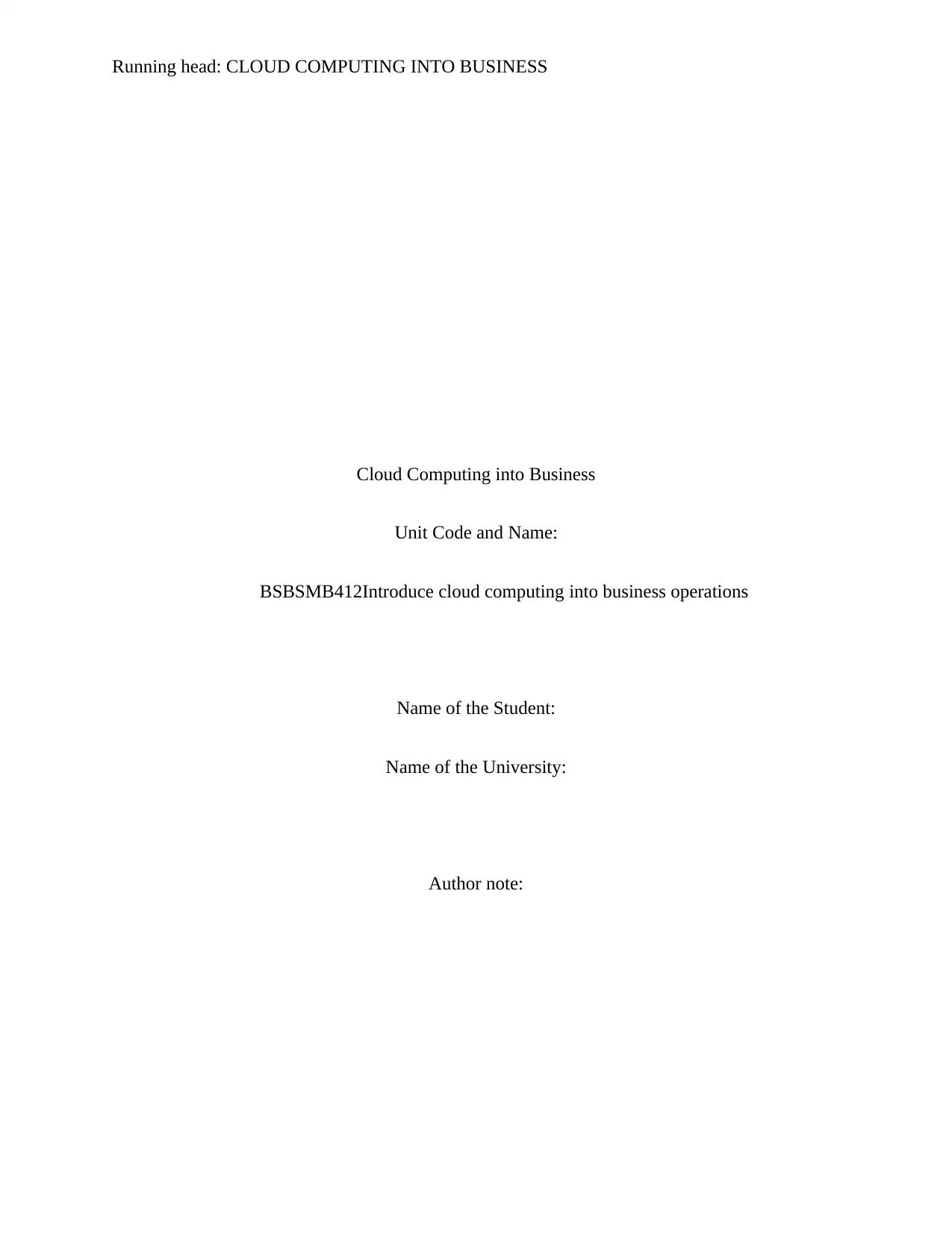
Running head: CLOUD COMPUTING INTO BUSINESS
Cloud Computing into Business
Unit Code and Name:
BSBSMB412Introduce cloud computing into business operations
Name of the Student:
Name of the University:
Author note:
Cloud Computing into Business
Unit Code and Name:
BSBSMB412Introduce cloud computing into business operations
Name of the Student:
Name of the University:
Author note:
Paraphrase This Document
Need a fresh take? Get an instant paraphrase of this document with our AI Paraphraser
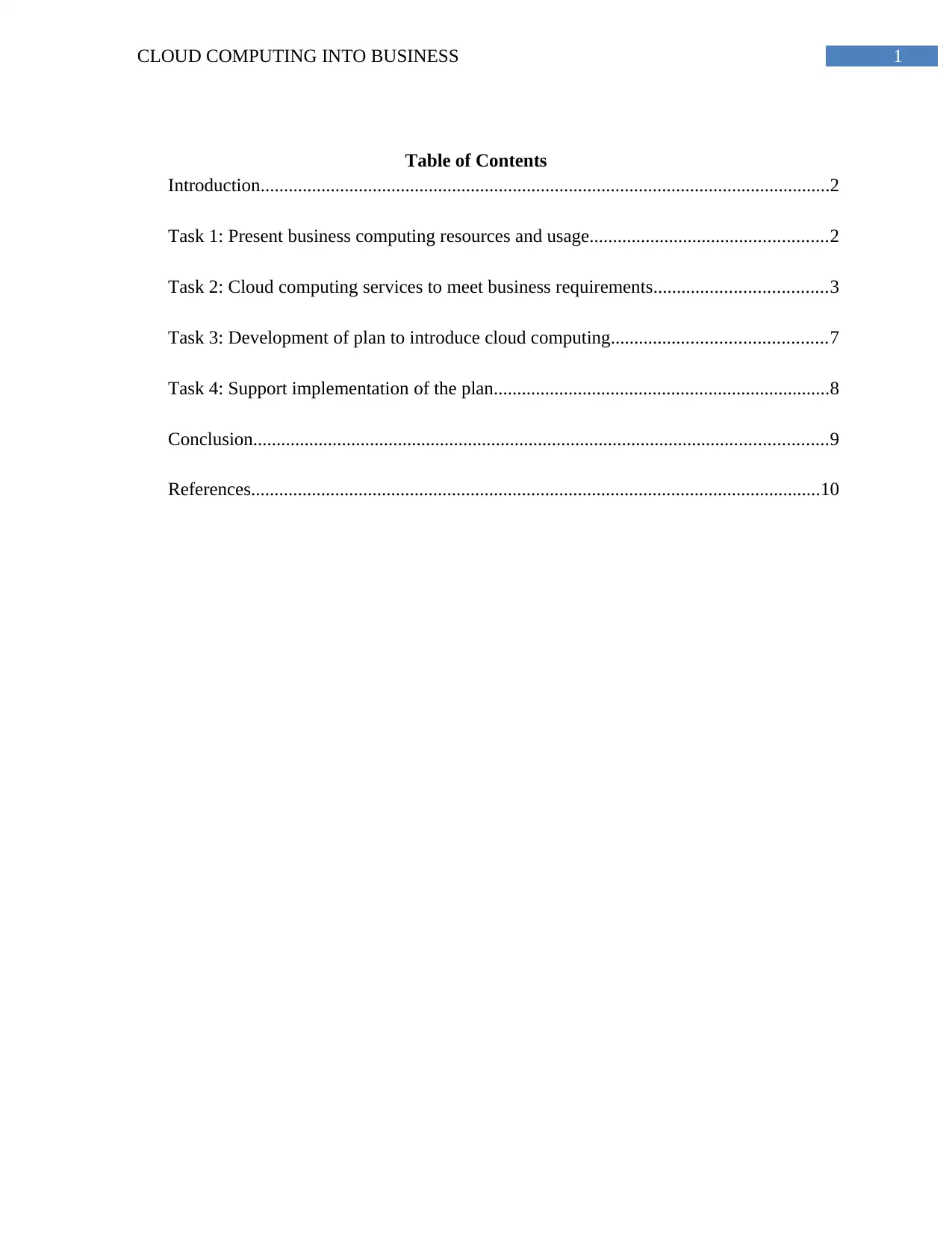
1CLOUD COMPUTING INTO BUSINESS
Table of Contents
Introduction..........................................................................................................................2
Task 1: Present business computing resources and usage...................................................2
Task 2: Cloud computing services to meet business requirements.....................................3
Task 3: Development of plan to introduce cloud computing..............................................7
Task 4: Support implementation of the plan........................................................................8
Conclusion...........................................................................................................................9
References..........................................................................................................................10
Table of Contents
Introduction..........................................................................................................................2
Task 1: Present business computing resources and usage...................................................2
Task 2: Cloud computing services to meet business requirements.....................................3
Task 3: Development of plan to introduce cloud computing..............................................7
Task 4: Support implementation of the plan........................................................................8
Conclusion...........................................................................................................................9
References..........................................................................................................................10
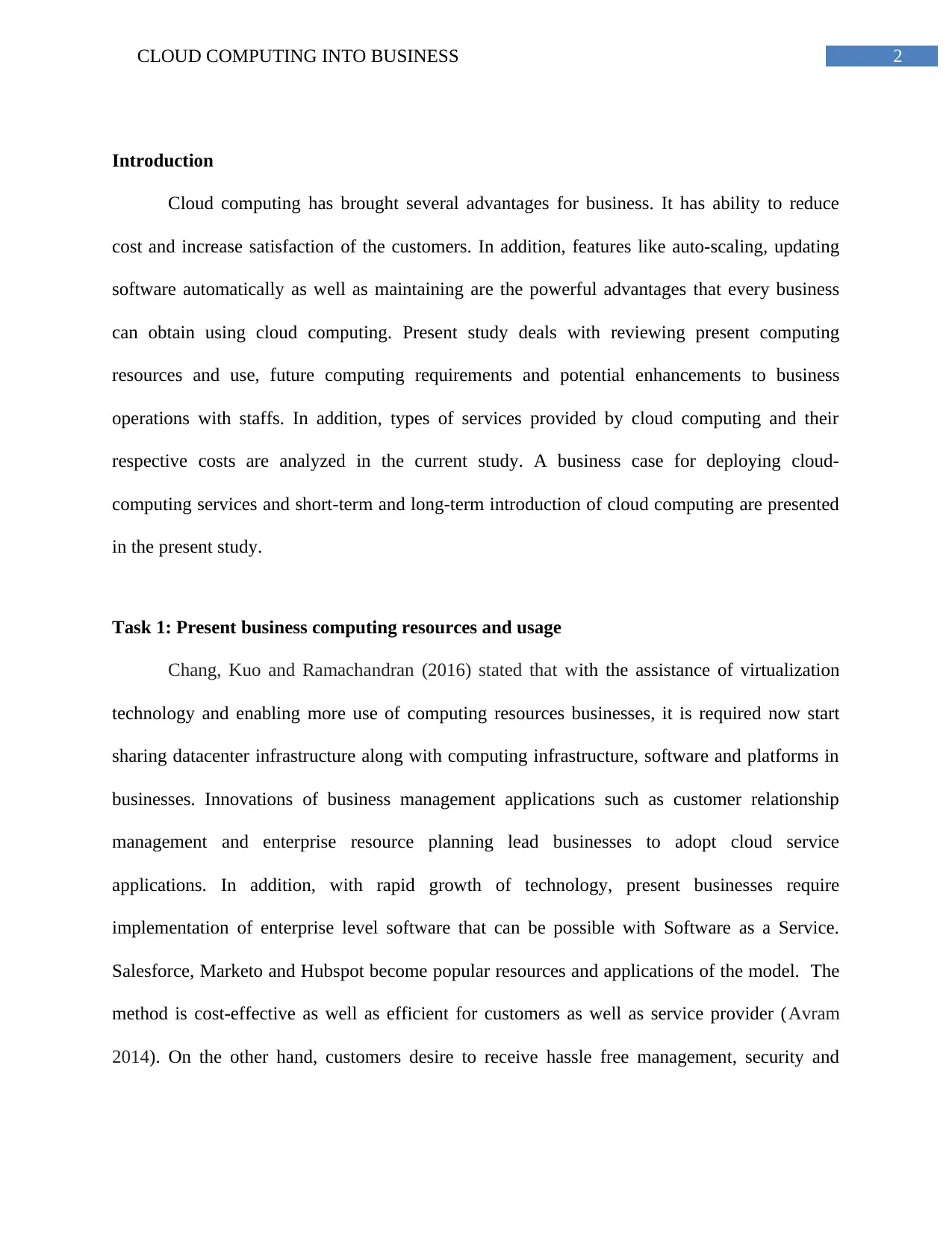
2CLOUD COMPUTING INTO BUSINESS
Introduction
Cloud computing has brought several advantages for business. It has ability to reduce
cost and increase satisfaction of the customers. In addition, features like auto-scaling, updating
software automatically as well as maintaining are the powerful advantages that every business
can obtain using cloud computing. Present study deals with reviewing present computing
resources and use, future computing requirements and potential enhancements to business
operations with staffs. In addition, types of services provided by cloud computing and their
respective costs are analyzed in the current study. A business case for deploying cloud-
computing services and short-term and long-term introduction of cloud computing are presented
in the present study.
Task 1: Present business computing resources and usage
Chang, Kuo and Ramachandran (2016) stated that with the assistance of virtualization
technology and enabling more use of computing resources businesses, it is required now start
sharing datacenter infrastructure along with computing infrastructure, software and platforms in
businesses. Innovations of business management applications such as customer relationship
management and enterprise resource planning lead businesses to adopt cloud service
applications. In addition, with rapid growth of technology, present businesses require
implementation of enterprise level software that can be possible with Software as a Service.
Salesforce, Marketo and Hubspot become popular resources and applications of the model. The
method is cost-effective as well as efficient for customers as well as service provider (Avram
2014). On the other hand, customers desire to receive hassle free management, security and
Introduction
Cloud computing has brought several advantages for business. It has ability to reduce
cost and increase satisfaction of the customers. In addition, features like auto-scaling, updating
software automatically as well as maintaining are the powerful advantages that every business
can obtain using cloud computing. Present study deals with reviewing present computing
resources and use, future computing requirements and potential enhancements to business
operations with staffs. In addition, types of services provided by cloud computing and their
respective costs are analyzed in the current study. A business case for deploying cloud-
computing services and short-term and long-term introduction of cloud computing are presented
in the present study.
Task 1: Present business computing resources and usage
Chang, Kuo and Ramachandran (2016) stated that with the assistance of virtualization
technology and enabling more use of computing resources businesses, it is required now start
sharing datacenter infrastructure along with computing infrastructure, software and platforms in
businesses. Innovations of business management applications such as customer relationship
management and enterprise resource planning lead businesses to adopt cloud service
applications. In addition, with rapid growth of technology, present businesses require
implementation of enterprise level software that can be possible with Software as a Service.
Salesforce, Marketo and Hubspot become popular resources and applications of the model. The
method is cost-effective as well as efficient for customers as well as service provider (Avram
2014). On the other hand, customers desire to receive hassle free management, security and
⊘ This is a preview!⊘
Do you want full access?
Subscribe today to unlock all pages.

Trusted by 1+ million students worldwide
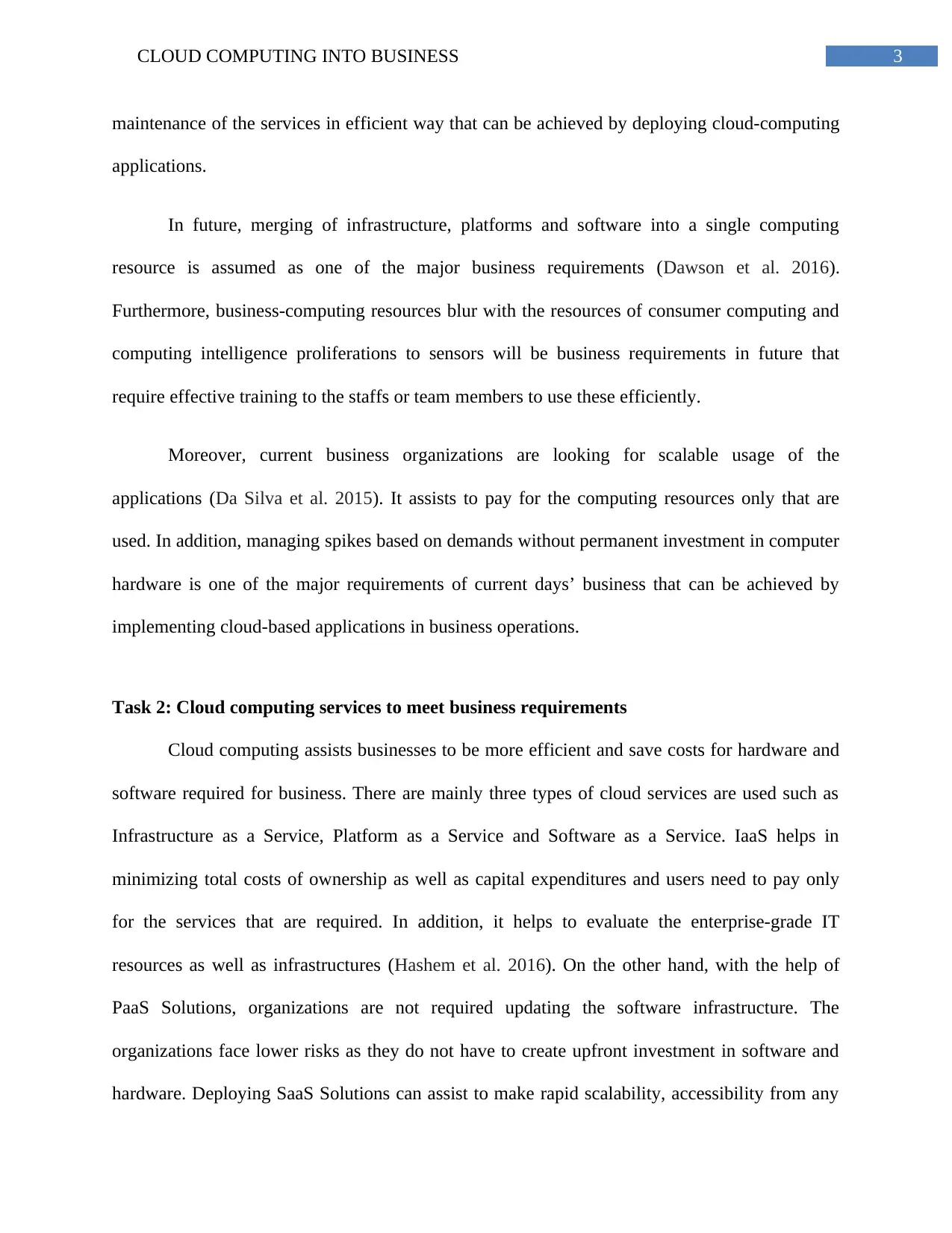
3CLOUD COMPUTING INTO BUSINESS
maintenance of the services in efficient way that can be achieved by deploying cloud-computing
applications.
In future, merging of infrastructure, platforms and software into a single computing
resource is assumed as one of the major business requirements (Dawson et al. 2016).
Furthermore, business-computing resources blur with the resources of consumer computing and
computing intelligence proliferations to sensors will be business requirements in future that
require effective training to the staffs or team members to use these efficiently.
Moreover, current business organizations are looking for scalable usage of the
applications (Da Silva et al. 2015). It assists to pay for the computing resources only that are
used. In addition, managing spikes based on demands without permanent investment in computer
hardware is one of the major requirements of current days’ business that can be achieved by
implementing cloud-based applications in business operations.
Task 2: Cloud computing services to meet business requirements
Cloud computing assists businesses to be more efficient and save costs for hardware and
software required for business. There are mainly three types of cloud services are used such as
Infrastructure as a Service, Platform as a Service and Software as a Service. IaaS helps in
minimizing total costs of ownership as well as capital expenditures and users need to pay only
for the services that are required. In addition, it helps to evaluate the enterprise-grade IT
resources as well as infrastructures (Hashem et al. 2016). On the other hand, with the help of
PaaS Solutions, organizations are not required updating the software infrastructure. The
organizations face lower risks as they do not have to create upfront investment in software and
hardware. Deploying SaaS Solutions can assist to make rapid scalability, accessibility from any
maintenance of the services in efficient way that can be achieved by deploying cloud-computing
applications.
In future, merging of infrastructure, platforms and software into a single computing
resource is assumed as one of the major business requirements (Dawson et al. 2016).
Furthermore, business-computing resources blur with the resources of consumer computing and
computing intelligence proliferations to sensors will be business requirements in future that
require effective training to the staffs or team members to use these efficiently.
Moreover, current business organizations are looking for scalable usage of the
applications (Da Silva et al. 2015). It assists to pay for the computing resources only that are
used. In addition, managing spikes based on demands without permanent investment in computer
hardware is one of the major requirements of current days’ business that can be achieved by
implementing cloud-based applications in business operations.
Task 2: Cloud computing services to meet business requirements
Cloud computing assists businesses to be more efficient and save costs for hardware and
software required for business. There are mainly three types of cloud services are used such as
Infrastructure as a Service, Platform as a Service and Software as a Service. IaaS helps in
minimizing total costs of ownership as well as capital expenditures and users need to pay only
for the services that are required. In addition, it helps to evaluate the enterprise-grade IT
resources as well as infrastructures (Hashem et al. 2016). On the other hand, with the help of
PaaS Solutions, organizations are not required updating the software infrastructure. The
organizations face lower risks as they do not have to create upfront investment in software and
hardware. Deploying SaaS Solutions can assist to make rapid scalability, accessibility from any
Paraphrase This Document
Need a fresh take? Get an instant paraphrase of this document with our AI Paraphraser
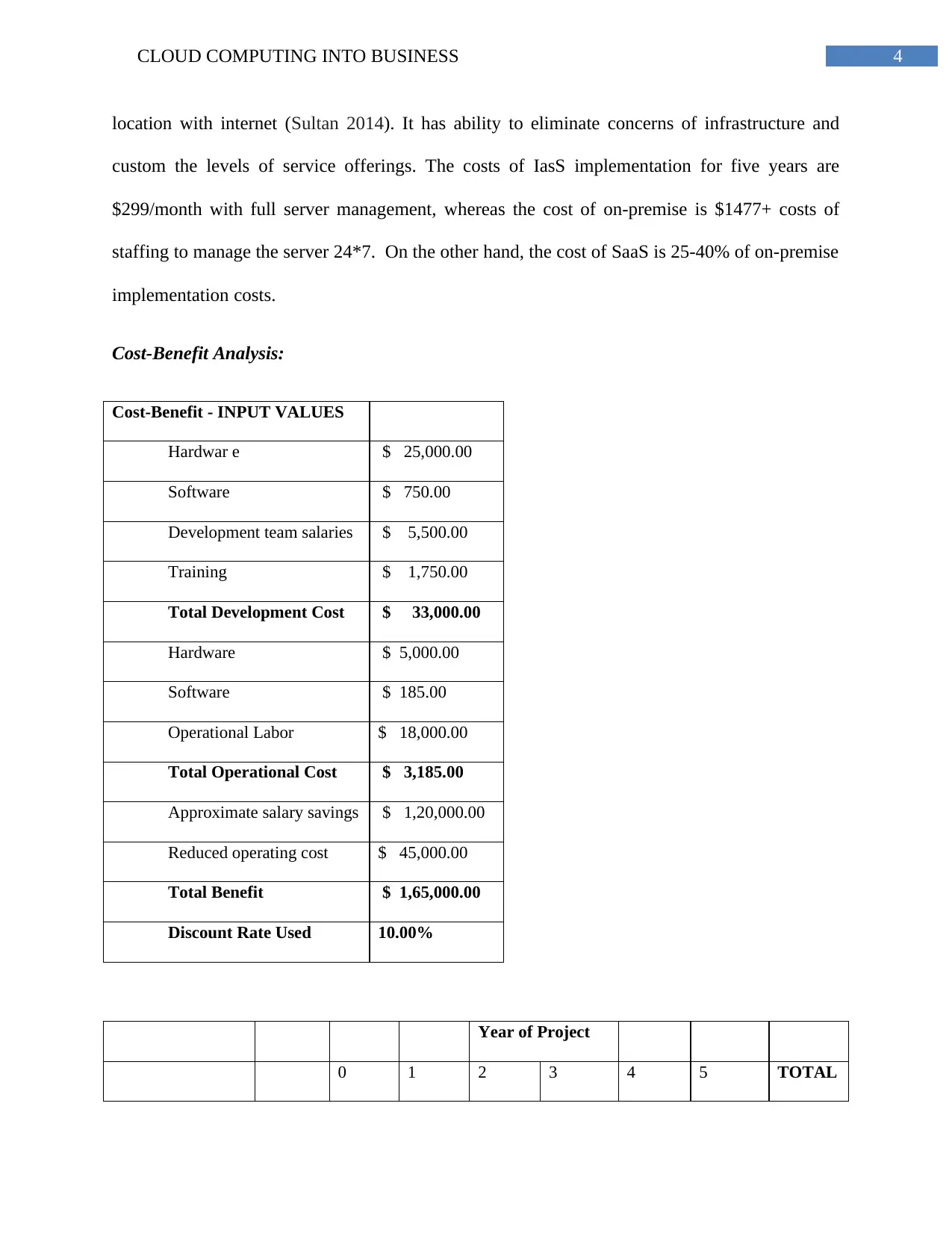
4CLOUD COMPUTING INTO BUSINESS
location with internet (Sultan 2014). It has ability to eliminate concerns of infrastructure and
custom the levels of service offerings. The costs of IasS implementation for five years are
$299/month with full server management, whereas the cost of on-premise is $1477+ costs of
staffing to manage the server 24*7. On the other hand, the cost of SaaS is 25-40% of on-premise
implementation costs.
Cost-Benefit Analysis:
Cost-Benefit - INPUT VALUES
Hardwar e $ 25,000.00
Software $ 750.00
Development team salaries $ 5,500.00
Training $ 1,750.00
Total Development Cost $ 33,000.00
Hardware $ 5,000.00
Software $ 185.00
Operational Labor $ 18,000.00
Total Operational Cost $ 3,185.00
Approximate salary savings $ 1,20,000.00
Reduced operating cost $ 45,000.00
Total Benefit $ 1,65,000.00
Discount Rate Used 10.00%
Year of Project
0 1 2 3 4 5 TOTAL
location with internet (Sultan 2014). It has ability to eliminate concerns of infrastructure and
custom the levels of service offerings. The costs of IasS implementation for five years are
$299/month with full server management, whereas the cost of on-premise is $1477+ costs of
staffing to manage the server 24*7. On the other hand, the cost of SaaS is 25-40% of on-premise
implementation costs.
Cost-Benefit Analysis:
Cost-Benefit - INPUT VALUES
Hardwar e $ 25,000.00
Software $ 750.00
Development team salaries $ 5,500.00
Training $ 1,750.00
Total Development Cost $ 33,000.00
Hardware $ 5,000.00
Software $ 185.00
Operational Labor $ 18,000.00
Total Operational Cost $ 3,185.00
Approximate salary savings $ 1,20,000.00
Reduced operating cost $ 45,000.00
Total Benefit $ 1,65,000.00
Discount Rate Used 10.00%
Year of Project
0 1 2 3 4 5 TOTAL
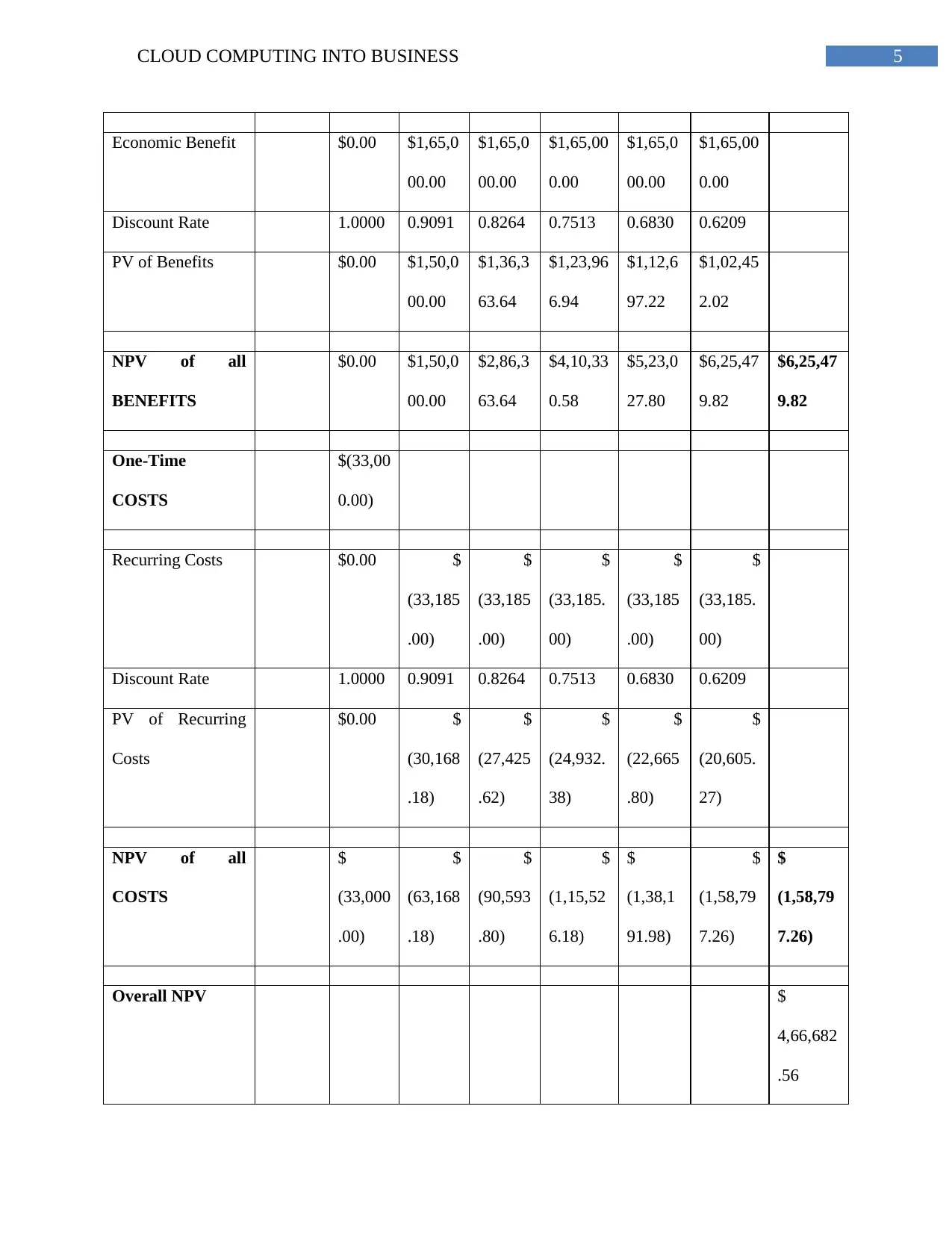
5CLOUD COMPUTING INTO BUSINESS
Economic Benefit $0.00 $1,65,0
00.00
$1,65,0
00.00
$1,65,00
0.00
$1,65,0
00.00
$1,65,00
0.00
Discount Rate 1.0000 0.9091 0.8264 0.7513 0.6830 0.6209
PV of Benefits $0.00 $1,50,0
00.00
$1,36,3
63.64
$1,23,96
6.94
$1,12,6
97.22
$1,02,45
2.02
NPV of all
BENEFITS
$0.00 $1,50,0
00.00
$2,86,3
63.64
$4,10,33
0.58
$5,23,0
27.80
$6,25,47
9.82
$6,25,47
9.82
One-Time
COSTS
$(33,00
0.00)
Recurring Costs $0.00 $
(33,185
.00)
$
(33,185
.00)
$
(33,185.
00)
$
(33,185
.00)
$
(33,185.
00)
Discount Rate 1.0000 0.9091 0.8264 0.7513 0.6830 0.6209
PV of Recurring
Costs
$0.00 $
(30,168
.18)
$
(27,425
.62)
$
(24,932.
38)
$
(22,665
.80)
$
(20,605.
27)
NPV of all
COSTS
$
(33,000
.00)
$
(63,168
.18)
$
(90,593
.80)
$
(1,15,52
6.18)
$
(1,38,1
91.98)
$
(1,58,79
7.26)
$
(1,58,79
7.26)
Overall NPV $
4,66,682
.56
Economic Benefit $0.00 $1,65,0
00.00
$1,65,0
00.00
$1,65,00
0.00
$1,65,0
00.00
$1,65,00
0.00
Discount Rate 1.0000 0.9091 0.8264 0.7513 0.6830 0.6209
PV of Benefits $0.00 $1,50,0
00.00
$1,36,3
63.64
$1,23,96
6.94
$1,12,6
97.22
$1,02,45
2.02
NPV of all
BENEFITS
$0.00 $1,50,0
00.00
$2,86,3
63.64
$4,10,33
0.58
$5,23,0
27.80
$6,25,47
9.82
$6,25,47
9.82
One-Time
COSTS
$(33,00
0.00)
Recurring Costs $0.00 $
(33,185
.00)
$
(33,185
.00)
$
(33,185.
00)
$
(33,185
.00)
$
(33,185.
00)
Discount Rate 1.0000 0.9091 0.8264 0.7513 0.6830 0.6209
PV of Recurring
Costs
$0.00 $
(30,168
.18)
$
(27,425
.62)
$
(24,932.
38)
$
(22,665
.80)
$
(20,605.
27)
NPV of all
COSTS
$
(33,000
.00)
$
(63,168
.18)
$
(90,593
.80)
$
(1,15,52
6.18)
$
(1,38,1
91.98)
$
(1,58,79
7.26)
$
(1,58,79
7.26)
Overall NPV $
4,66,682
.56
⊘ This is a preview!⊘
Do you want full access?
Subscribe today to unlock all pages.

Trusted by 1+ million students worldwide
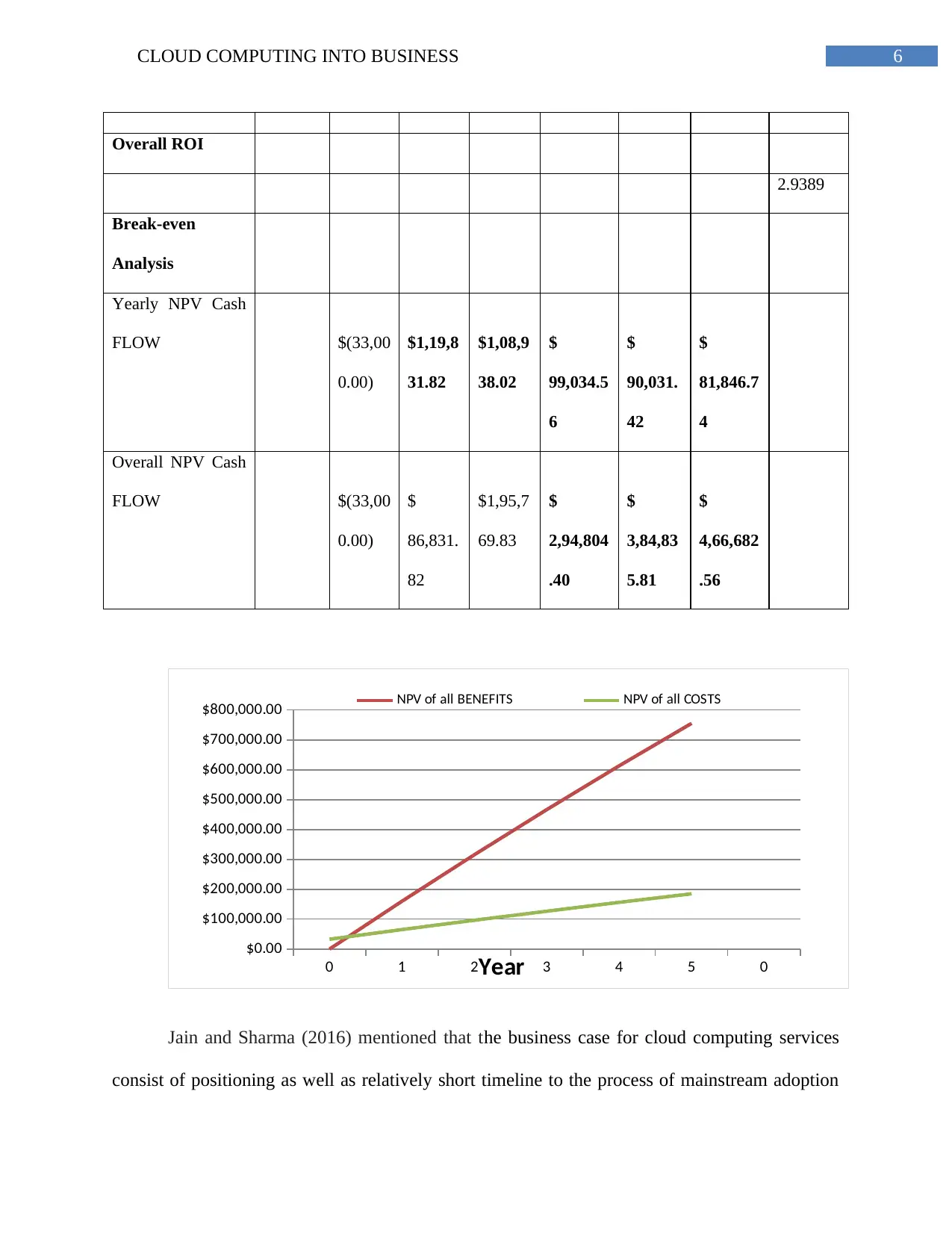
6CLOUD COMPUTING INTO BUSINESS
Overall ROI
2.9389
Break-even
Analysis
Yearly NPV Cash
FLOW $(33,00
0.00)
$1,19,8
31.82
$1,08,9
38.02
$
99,034.5
6
$
90,031.
42
$
81,846.7
4
Overall NPV Cash
FLOW $(33,00
0.00)
$
86,831.
82
$1,95,7
69.83
$
2,94,804
.40
$
3,84,83
5.81
$
4,66,682
.56
0 1 2 3 4 5 0
$0.00
$100,000.00
$200,000.00
$300,000.00
$400,000.00
$500,000.00
$600,000.00
$700,000.00
$800,000.00 NPV of all BENEFITS NPV of all COSTS
Year
Jain and Sharma (2016) mentioned that the business case for cloud computing services
consist of positioning as well as relatively short timeline to the process of mainstream adoption
Overall ROI
2.9389
Break-even
Analysis
Yearly NPV Cash
FLOW $(33,00
0.00)
$1,19,8
31.82
$1,08,9
38.02
$
99,034.5
6
$
90,031.
42
$
81,846.7
4
Overall NPV Cash
FLOW $(33,00
0.00)
$
86,831.
82
$1,95,7
69.83
$
2,94,804
.40
$
3,84,83
5.81
$
4,66,682
.56
0 1 2 3 4 5 0
$0.00
$100,000.00
$200,000.00
$300,000.00
$400,000.00
$500,000.00
$600,000.00
$700,000.00
$800,000.00 NPV of all BENEFITS NPV of all COSTS
Year
Jain and Sharma (2016) mentioned that the business case for cloud computing services
consist of positioning as well as relatively short timeline to the process of mainstream adoption
Paraphrase This Document
Need a fresh take? Get an instant paraphrase of this document with our AI Paraphraser
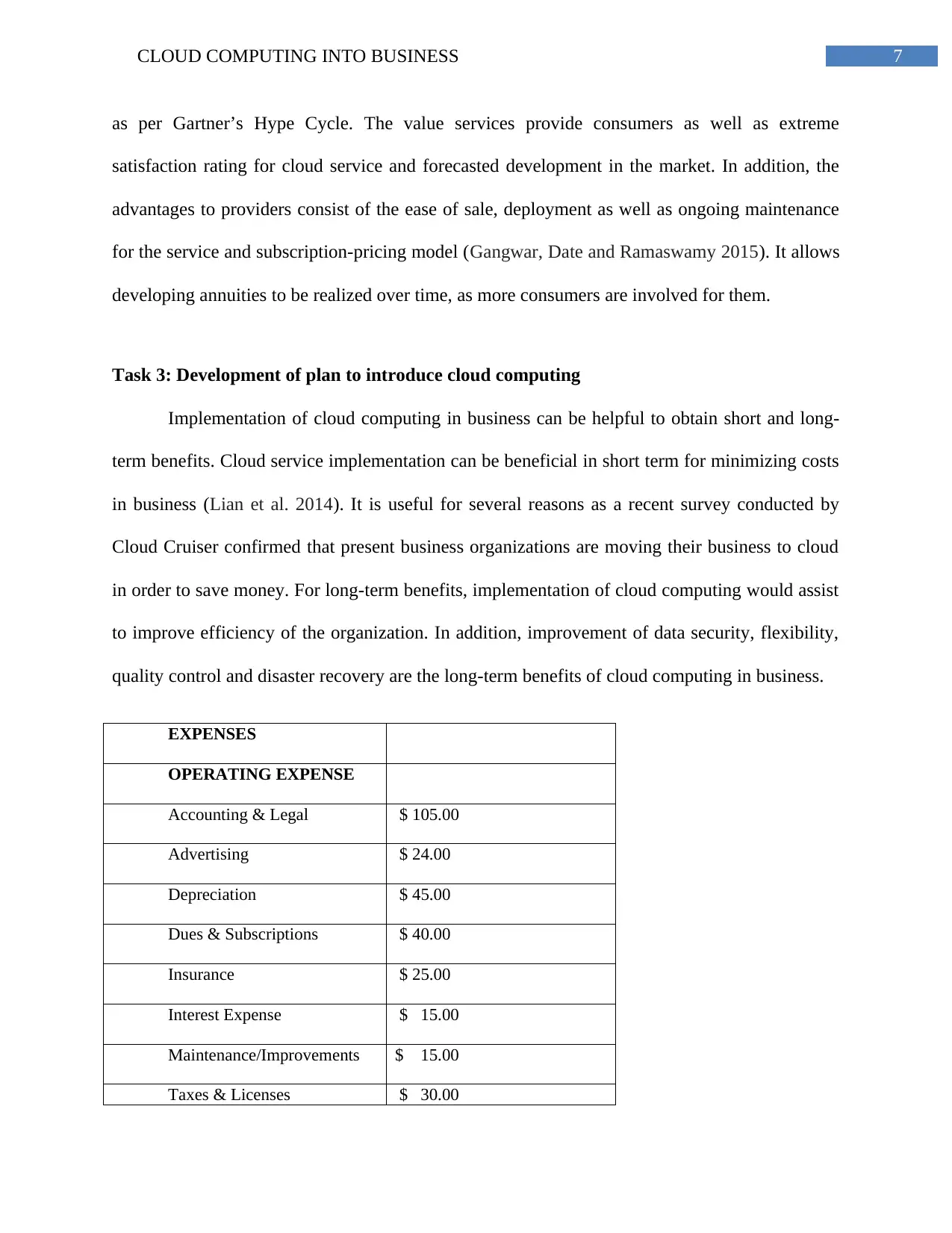
7CLOUD COMPUTING INTO BUSINESS
as per Gartner’s Hype Cycle. The value services provide consumers as well as extreme
satisfaction rating for cloud service and forecasted development in the market. In addition, the
advantages to providers consist of the ease of sale, deployment as well as ongoing maintenance
for the service and subscription-pricing model (Gangwar, Date and Ramaswamy 2015). It allows
developing annuities to be realized over time, as more consumers are involved for them.
Task 3: Development of plan to introduce cloud computing
Implementation of cloud computing in business can be helpful to obtain short and long-
term benefits. Cloud service implementation can be beneficial in short term for minimizing costs
in business (Lian et al. 2014). It is useful for several reasons as a recent survey conducted by
Cloud Cruiser confirmed that present business organizations are moving their business to cloud
in order to save money. For long-term benefits, implementation of cloud computing would assist
to improve efficiency of the organization. In addition, improvement of data security, flexibility,
quality control and disaster recovery are the long-term benefits of cloud computing in business.
EXPENSES
OPERATING EXPENSE
Accounting & Legal $ 105.00
Advertising $ 24.00
Depreciation $ 45.00
Dues & Subscriptions $ 40.00
Insurance $ 25.00
Interest Expense $ 15.00
Maintenance/Improvements $ 15.00
Taxes & Licenses $ 30.00
as per Gartner’s Hype Cycle. The value services provide consumers as well as extreme
satisfaction rating for cloud service and forecasted development in the market. In addition, the
advantages to providers consist of the ease of sale, deployment as well as ongoing maintenance
for the service and subscription-pricing model (Gangwar, Date and Ramaswamy 2015). It allows
developing annuities to be realized over time, as more consumers are involved for them.
Task 3: Development of plan to introduce cloud computing
Implementation of cloud computing in business can be helpful to obtain short and long-
term benefits. Cloud service implementation can be beneficial in short term for minimizing costs
in business (Lian et al. 2014). It is useful for several reasons as a recent survey conducted by
Cloud Cruiser confirmed that present business organizations are moving their business to cloud
in order to save money. For long-term benefits, implementation of cloud computing would assist
to improve efficiency of the organization. In addition, improvement of data security, flexibility,
quality control and disaster recovery are the long-term benefits of cloud computing in business.
EXPENSES
OPERATING EXPENSE
Accounting & Legal $ 105.00
Advertising $ 24.00
Depreciation $ 45.00
Dues & Subscriptions $ 40.00
Insurance $ 25.00
Interest Expense $ 15.00
Maintenance/Improvements $ 15.00
Taxes & Licenses $ 30.00
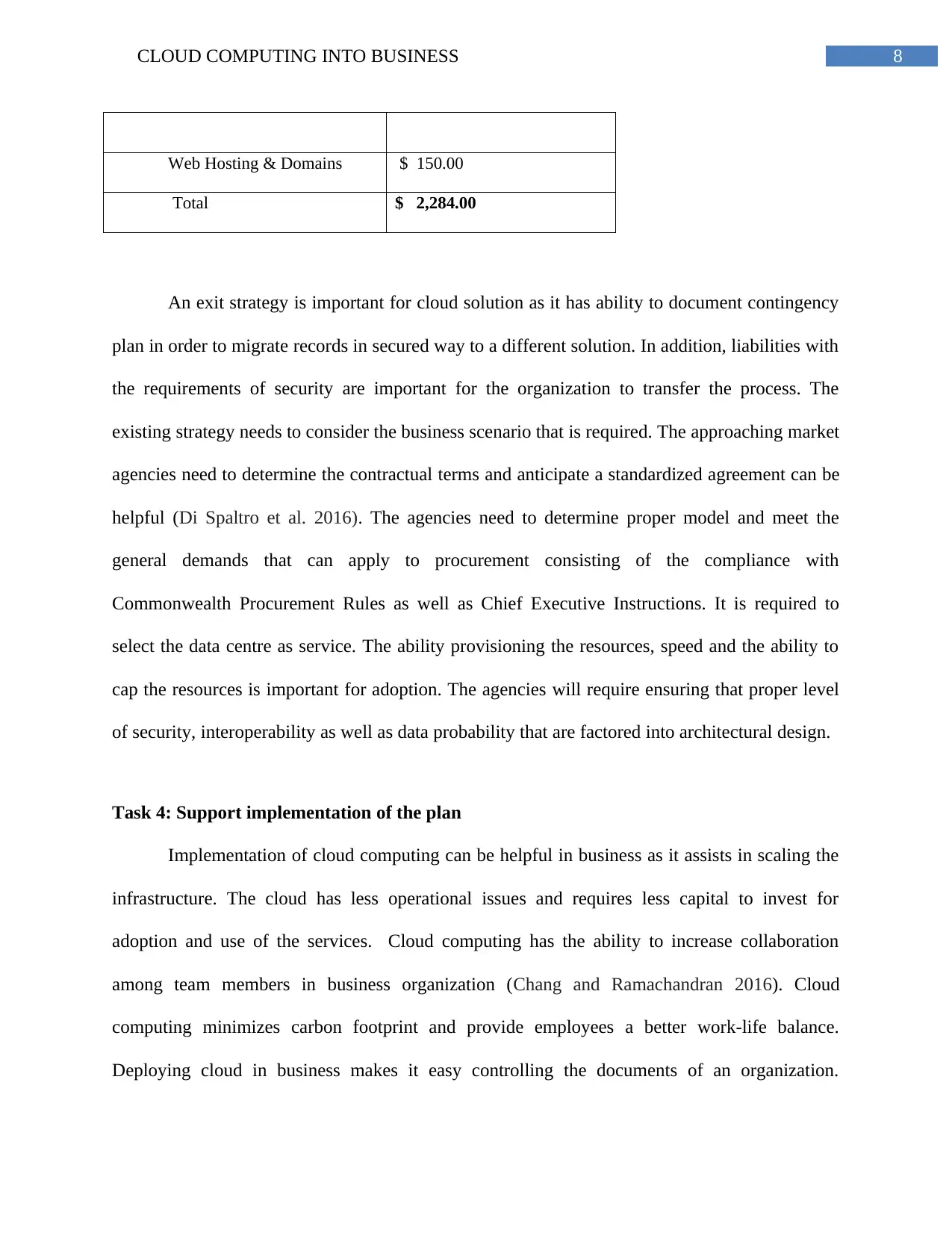
8CLOUD COMPUTING INTO BUSINESS
Web Hosting & Domains $ 150.00
Total $ 2,284.00
An exit strategy is important for cloud solution as it has ability to document contingency
plan in order to migrate records in secured way to a different solution. In addition, liabilities with
the requirements of security are important for the organization to transfer the process. The
existing strategy needs to consider the business scenario that is required. The approaching market
agencies need to determine the contractual terms and anticipate a standardized agreement can be
helpful (Di Spaltro et al. 2016). The agencies need to determine proper model and meet the
general demands that can apply to procurement consisting of the compliance with
Commonwealth Procurement Rules as well as Chief Executive Instructions. It is required to
select the data centre as service. The ability provisioning the resources, speed and the ability to
cap the resources is important for adoption. The agencies will require ensuring that proper level
of security, interoperability as well as data probability that are factored into architectural design.
Task 4: Support implementation of the plan
Implementation of cloud computing can be helpful in business as it assists in scaling the
infrastructure. The cloud has less operational issues and requires less capital to invest for
adoption and use of the services. Cloud computing has the ability to increase collaboration
among team members in business organization (Chang and Ramachandran 2016). Cloud
computing minimizes carbon footprint and provide employees a better work-life balance.
Deploying cloud in business makes it easy controlling the documents of an organization.
Web Hosting & Domains $ 150.00
Total $ 2,284.00
An exit strategy is important for cloud solution as it has ability to document contingency
plan in order to migrate records in secured way to a different solution. In addition, liabilities with
the requirements of security are important for the organization to transfer the process. The
existing strategy needs to consider the business scenario that is required. The approaching market
agencies need to determine the contractual terms and anticipate a standardized agreement can be
helpful (Di Spaltro et al. 2016). The agencies need to determine proper model and meet the
general demands that can apply to procurement consisting of the compliance with
Commonwealth Procurement Rules as well as Chief Executive Instructions. It is required to
select the data centre as service. The ability provisioning the resources, speed and the ability to
cap the resources is important for adoption. The agencies will require ensuring that proper level
of security, interoperability as well as data probability that are factored into architectural design.
Task 4: Support implementation of the plan
Implementation of cloud computing can be helpful in business as it assists in scaling the
infrastructure. The cloud has less operational issues and requires less capital to invest for
adoption and use of the services. Cloud computing has the ability to increase collaboration
among team members in business organization (Chang and Ramachandran 2016). Cloud
computing minimizes carbon footprint and provide employees a better work-life balance.
Deploying cloud in business makes it easy controlling the documents of an organization.
⊘ This is a preview!⊘
Do you want full access?
Subscribe today to unlock all pages.

Trusted by 1+ million students worldwide
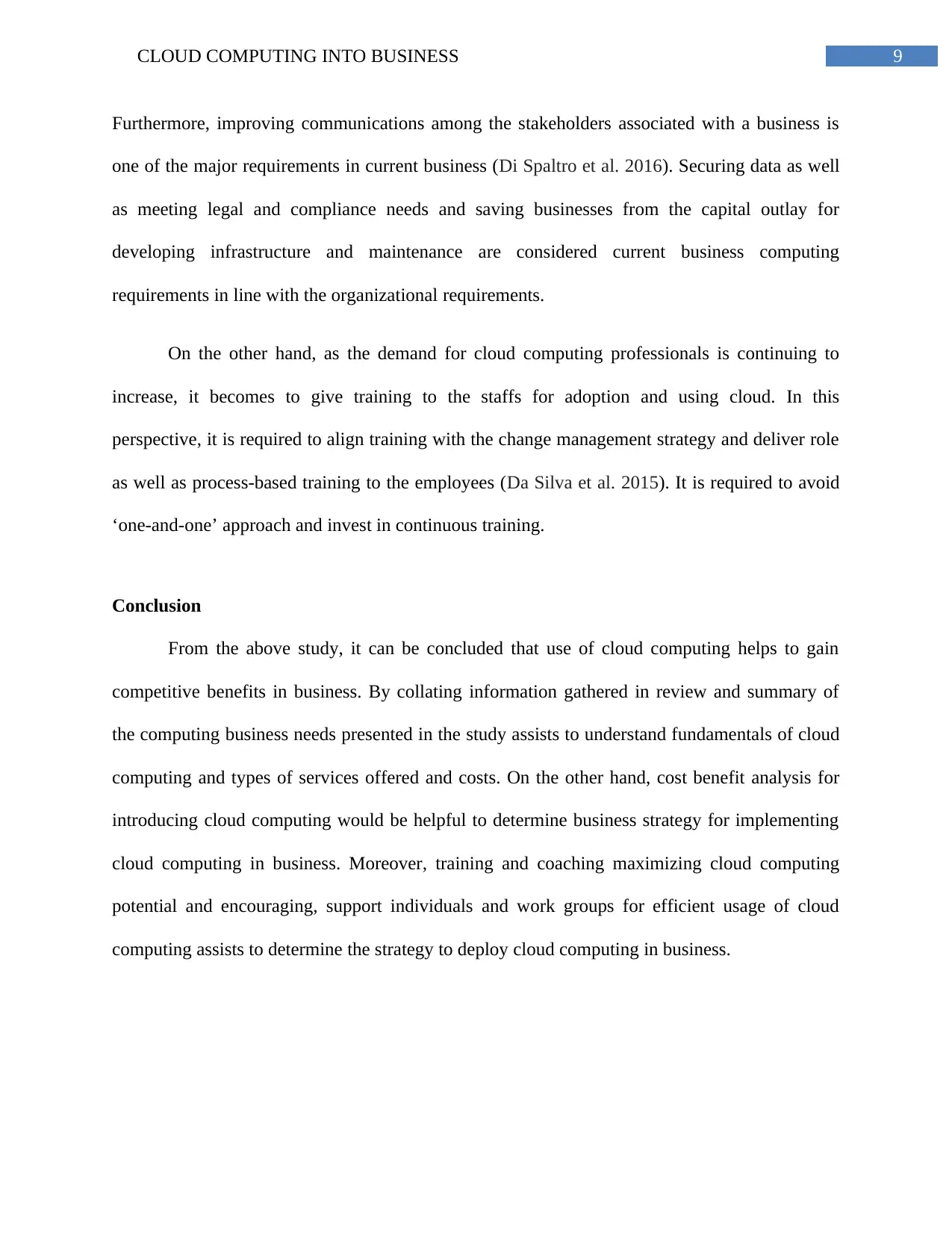
9CLOUD COMPUTING INTO BUSINESS
Furthermore, improving communications among the stakeholders associated with a business is
one of the major requirements in current business (Di Spaltro et al. 2016). Securing data as well
as meeting legal and compliance needs and saving businesses from the capital outlay for
developing infrastructure and maintenance are considered current business computing
requirements in line with the organizational requirements.
On the other hand, as the demand for cloud computing professionals is continuing to
increase, it becomes to give training to the staffs for adoption and using cloud. In this
perspective, it is required to align training with the change management strategy and deliver role
as well as process-based training to the employees (Da Silva et al. 2015). It is required to avoid
‘one-and-one’ approach and invest in continuous training.
Conclusion
From the above study, it can be concluded that use of cloud computing helps to gain
competitive benefits in business. By collating information gathered in review and summary of
the computing business needs presented in the study assists to understand fundamentals of cloud
computing and types of services offered and costs. On the other hand, cost benefit analysis for
introducing cloud computing would be helpful to determine business strategy for implementing
cloud computing in business. Moreover, training and coaching maximizing cloud computing
potential and encouraging, support individuals and work groups for efficient usage of cloud
computing assists to determine the strategy to deploy cloud computing in business.
Furthermore, improving communications among the stakeholders associated with a business is
one of the major requirements in current business (Di Spaltro et al. 2016). Securing data as well
as meeting legal and compliance needs and saving businesses from the capital outlay for
developing infrastructure and maintenance are considered current business computing
requirements in line with the organizational requirements.
On the other hand, as the demand for cloud computing professionals is continuing to
increase, it becomes to give training to the staffs for adoption and using cloud. In this
perspective, it is required to align training with the change management strategy and deliver role
as well as process-based training to the employees (Da Silva et al. 2015). It is required to avoid
‘one-and-one’ approach and invest in continuous training.
Conclusion
From the above study, it can be concluded that use of cloud computing helps to gain
competitive benefits in business. By collating information gathered in review and summary of
the computing business needs presented in the study assists to understand fundamentals of cloud
computing and types of services offered and costs. On the other hand, cost benefit analysis for
introducing cloud computing would be helpful to determine business strategy for implementing
cloud computing in business. Moreover, training and coaching maximizing cloud computing
potential and encouraging, support individuals and work groups for efficient usage of cloud
computing assists to determine the strategy to deploy cloud computing in business.
Paraphrase This Document
Need a fresh take? Get an instant paraphrase of this document with our AI Paraphraser
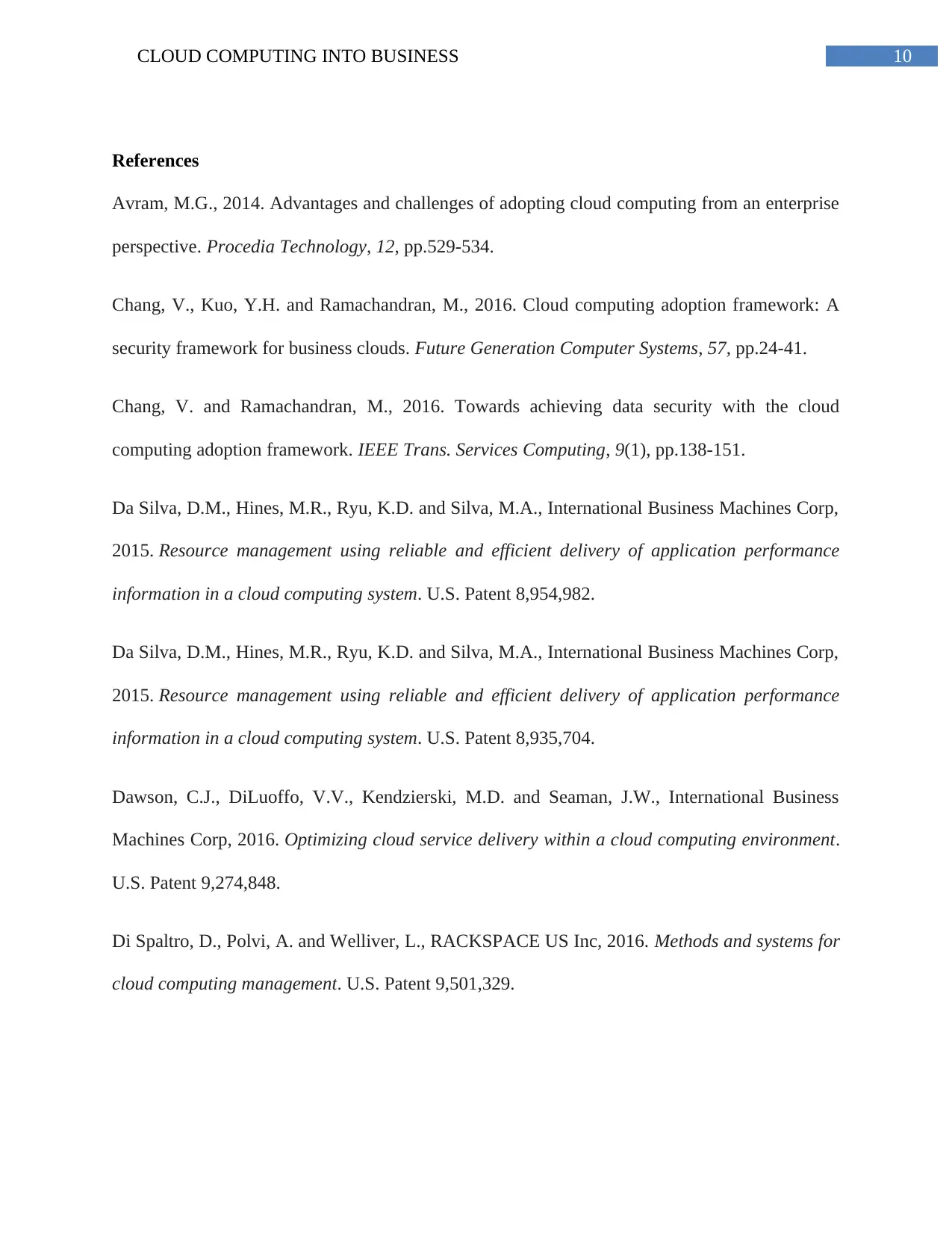
10CLOUD COMPUTING INTO BUSINESS
References
Avram, M.G., 2014. Advantages and challenges of adopting cloud computing from an enterprise
perspective. Procedia Technology, 12, pp.529-534.
Chang, V., Kuo, Y.H. and Ramachandran, M., 2016. Cloud computing adoption framework: A
security framework for business clouds. Future Generation Computer Systems, 57, pp.24-41.
Chang, V. and Ramachandran, M., 2016. Towards achieving data security with the cloud
computing adoption framework. IEEE Trans. Services Computing, 9(1), pp.138-151.
Da Silva, D.M., Hines, M.R., Ryu, K.D. and Silva, M.A., International Business Machines Corp,
2015. Resource management using reliable and efficient delivery of application performance
information in a cloud computing system. U.S. Patent 8,954,982.
Da Silva, D.M., Hines, M.R., Ryu, K.D. and Silva, M.A., International Business Machines Corp,
2015. Resource management using reliable and efficient delivery of application performance
information in a cloud computing system. U.S. Patent 8,935,704.
Dawson, C.J., DiLuoffo, V.V., Kendzierski, M.D. and Seaman, J.W., International Business
Machines Corp, 2016. Optimizing cloud service delivery within a cloud computing environment.
U.S. Patent 9,274,848.
Di Spaltro, D., Polvi, A. and Welliver, L., RACKSPACE US Inc, 2016. Methods and systems for
cloud computing management. U.S. Patent 9,501,329.
References
Avram, M.G., 2014. Advantages and challenges of adopting cloud computing from an enterprise
perspective. Procedia Technology, 12, pp.529-534.
Chang, V., Kuo, Y.H. and Ramachandran, M., 2016. Cloud computing adoption framework: A
security framework for business clouds. Future Generation Computer Systems, 57, pp.24-41.
Chang, V. and Ramachandran, M., 2016. Towards achieving data security with the cloud
computing adoption framework. IEEE Trans. Services Computing, 9(1), pp.138-151.
Da Silva, D.M., Hines, M.R., Ryu, K.D. and Silva, M.A., International Business Machines Corp,
2015. Resource management using reliable and efficient delivery of application performance
information in a cloud computing system. U.S. Patent 8,954,982.
Da Silva, D.M., Hines, M.R., Ryu, K.D. and Silva, M.A., International Business Machines Corp,
2015. Resource management using reliable and efficient delivery of application performance
information in a cloud computing system. U.S. Patent 8,935,704.
Dawson, C.J., DiLuoffo, V.V., Kendzierski, M.D. and Seaman, J.W., International Business
Machines Corp, 2016. Optimizing cloud service delivery within a cloud computing environment.
U.S. Patent 9,274,848.
Di Spaltro, D., Polvi, A. and Welliver, L., RACKSPACE US Inc, 2016. Methods and systems for
cloud computing management. U.S. Patent 9,501,329.
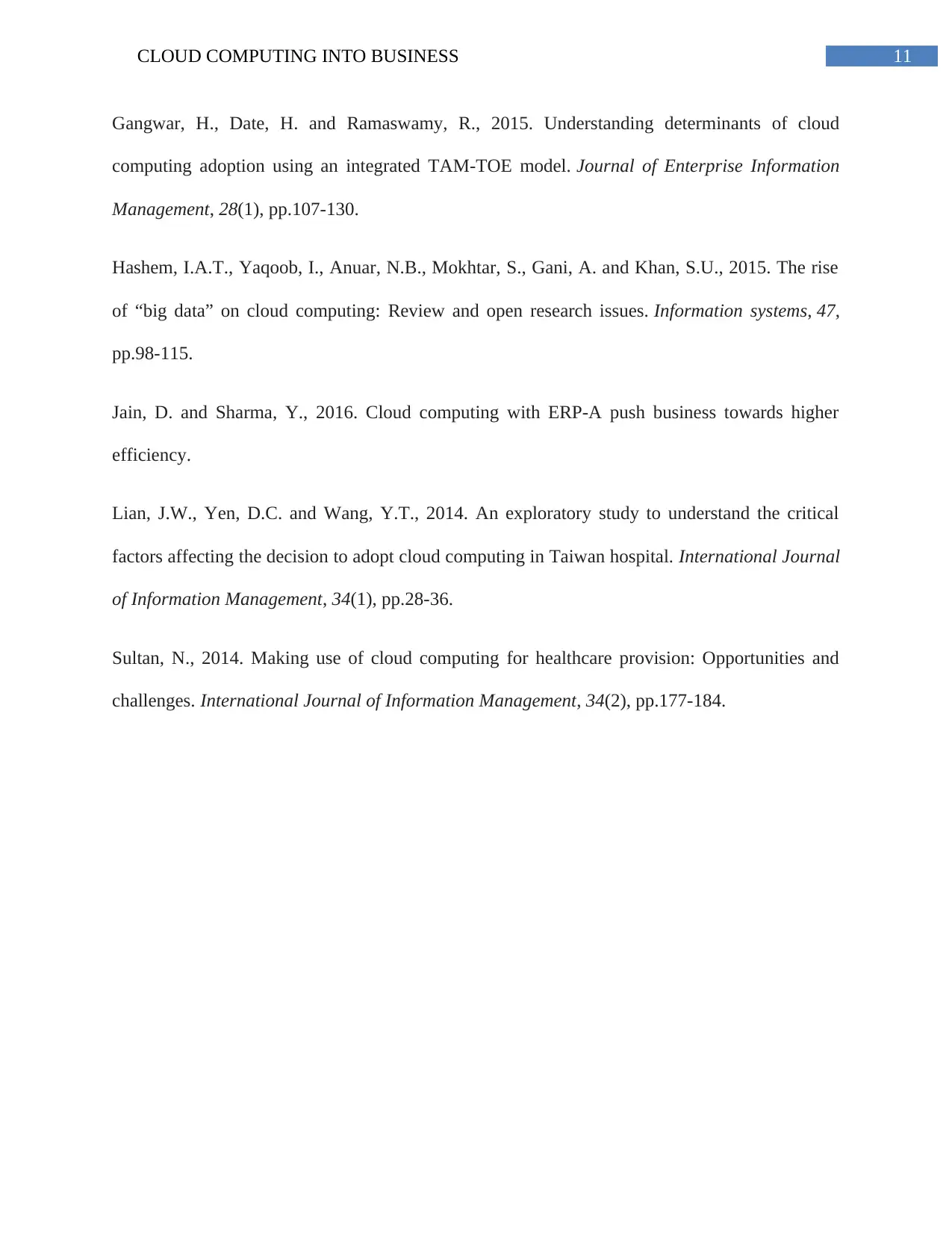
11CLOUD COMPUTING INTO BUSINESS
Gangwar, H., Date, H. and Ramaswamy, R., 2015. Understanding determinants of cloud
computing adoption using an integrated TAM-TOE model. Journal of Enterprise Information
Management, 28(1), pp.107-130.
Hashem, I.A.T., Yaqoob, I., Anuar, N.B., Mokhtar, S., Gani, A. and Khan, S.U., 2015. The rise
of “big data” on cloud computing: Review and open research issues. Information systems, 47,
pp.98-115.
Jain, D. and Sharma, Y., 2016. Cloud computing with ERP-A push business towards higher
efficiency.
Lian, J.W., Yen, D.C. and Wang, Y.T., 2014. An exploratory study to understand the critical
factors affecting the decision to adopt cloud computing in Taiwan hospital. International Journal
of Information Management, 34(1), pp.28-36.
Sultan, N., 2014. Making use of cloud computing for healthcare provision: Opportunities and
challenges. International Journal of Information Management, 34(2), pp.177-184.
Gangwar, H., Date, H. and Ramaswamy, R., 2015. Understanding determinants of cloud
computing adoption using an integrated TAM-TOE model. Journal of Enterprise Information
Management, 28(1), pp.107-130.
Hashem, I.A.T., Yaqoob, I., Anuar, N.B., Mokhtar, S., Gani, A. and Khan, S.U., 2015. The rise
of “big data” on cloud computing: Review and open research issues. Information systems, 47,
pp.98-115.
Jain, D. and Sharma, Y., 2016. Cloud computing with ERP-A push business towards higher
efficiency.
Lian, J.W., Yen, D.C. and Wang, Y.T., 2014. An exploratory study to understand the critical
factors affecting the decision to adopt cloud computing in Taiwan hospital. International Journal
of Information Management, 34(1), pp.28-36.
Sultan, N., 2014. Making use of cloud computing for healthcare provision: Opportunities and
challenges. International Journal of Information Management, 34(2), pp.177-184.
⊘ This is a preview!⊘
Do you want full access?
Subscribe today to unlock all pages.

Trusted by 1+ million students worldwide
1 out of 13
Related Documents
Your All-in-One AI-Powered Toolkit for Academic Success.
+13062052269
info@desklib.com
Available 24*7 on WhatsApp / Email
![[object Object]](/_next/static/media/star-bottom.7253800d.svg)
Unlock your academic potential
Copyright © 2020–2025 A2Z Services. All Rights Reserved. Developed and managed by ZUCOL.




